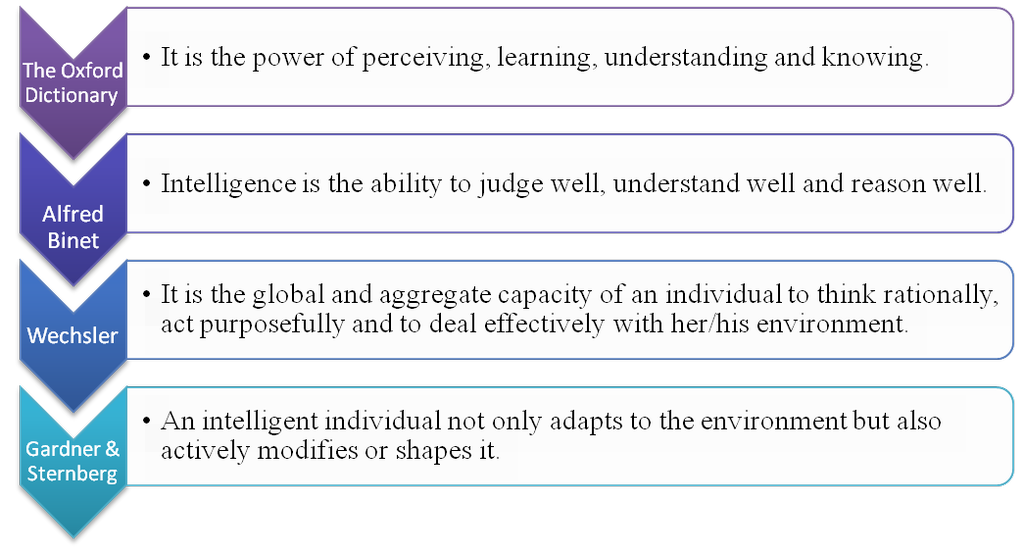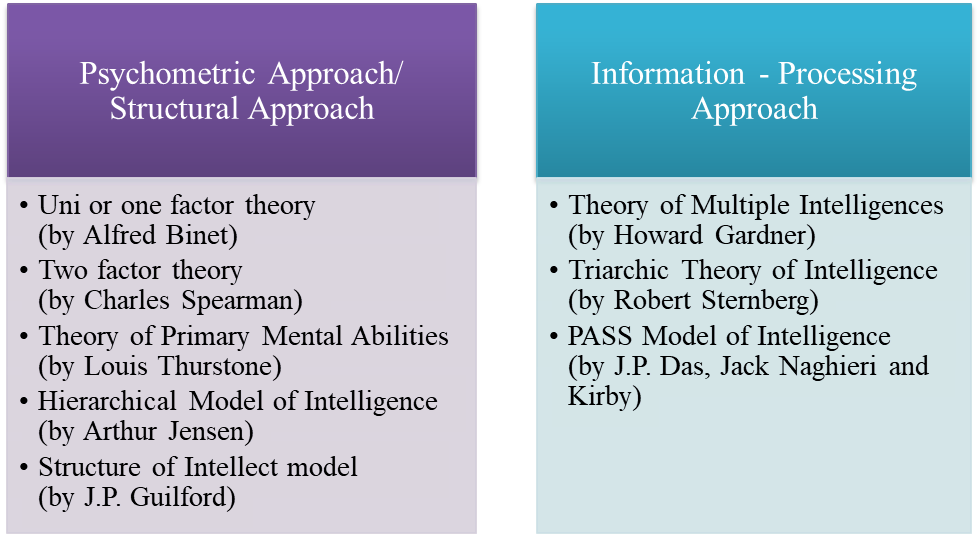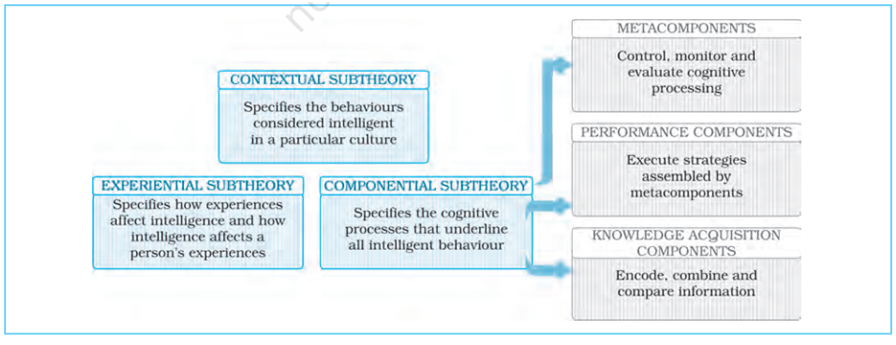- Books Name
- Psychology Book Class-12
- Publication
- PathSet Publications
- Course
- CBSE Class 12
- Subject
- Psychology
Definitions of Intelligence

Theories of Intelligence
There are two approaches to theories of intelligence:

Psychometric approach/ Structural approach
- considers intelligence as an aggregate of abilities
- expresses the individual's performance in terms of a single index of cognitive abilities
A. Uni or one factor theory (by Alfred Binet)
According to him, intelligence consists of one similar set of abilities which can be used for solving any or every problem in an individual's environment.
B. Two factor theory (by Charles Spearman)
According to him, intelligence consists of:
i. General factor (g-factor) which includes mental operations which are primary and common to all performances.
ii. Specific factors (s-factors) which contains specific abilities which allow individuals to excel in their respective domains / fields. For eg, singing, dancing, cooking etc.
C. Theory of Primary Mental Abilities (by Louis Thurstone)
It states that intelligence consists of 7 primary abilities, independent of each other:
i. Verbal Comprehension - grasping meaning of words, concepts and ideas
ii. Numerical Abilities - speed and accuracy in numerical and computational skills
iii. Spacial Relations - visualising patterns and forms
iv. Perceptual speed - speed in perceiving details
v. Word Fluency - using words fluently and flexibly
vi. Memory - accuracy in recalling information
vii. Inductive Reasoning - deriving general rules from presented facts
D. Hierarchical Model of Intelligence (by Arthur Jensen)
This model consists of abilities operating at two levels:
i. Level I
It is the associative learning in which output is more or less similar to the input (for eg rote learning and memory)
ii. Level II
It is also called cognitive competence which involves higher order skills as they transform the input to produce an effective output.
E. Structure of Intellect model (J.P. Guilford)
It classifies intellectual traits among 3 dimensions:
i. Operations
- what the respondent does
- includes cognition, memory recording, memery retention, divergent production, convergent production, and evaluation
ii. Contents
- the nature of materials or information on which intellectual operations are performed.
- includes visual, auditory, symbolic (letters and numbers), semantic (words), behavioural (information about people's behaviour, attitudes, needs).
iii. Products
- the form in which information is processed by the respondent.
- classified into units, classes, relations, systems, transformations, and implications.
Information-Processing Approach
- describes the processes people use in intellectual reasoning and problem solving
- focuses on how an intelligent person acts
- emphasizes on studying cognitive functions underlying intelligent behaviour
A. Theory of Multiple Intelligences (by Howard Gardner)
According to him,
- intelligence is not a single entity
- distinct types of intelligence exist -independent of each other
- different types of intelligences interact and work together to find a solution to a problem
He described 8 types of intelligences:
i. Linguitic Intelligence
- skills involved in the production and use of language
- use language fluently and flexibly
- to express one's thinking and understand others
- 'word-smart' people who are sensitive to different shades of word meanings, articulate, and can create linguistic images in their mind.
- examples: poets and writers
ii. Logical-Mathematical Intelligence
- skills in scientific thinking and problem solving
- think logically and critically
- engage in abstract reasoning
- can manipulate symbols to solve mathematical problems
- examples: Scientists and Nobel Prize winners
iii. Spatial Intelligence
- skills in forming visual images and patterns -abilities involved in forming, using, and transforming mental images.
- can easily represent the spatial world in the mind
- examples: Pilots, Sailors, Sculptors, Painters, Architects, Interior decorators, Surgeons
iv. Musical Intelligence
- sensitivity to musical rhythms and patterns
- capacity to produce, create and manipulate musical patterns
- sensitive to sounds and vibrations
- sensitive to creating new patterns of sounds
- examples: Musicians, Sound Engineers, Singers, Instrumentalists
v. Bodily-Kinaesthetic Intelligence
- using whole or portions of the body flexibly and creatively for display or construction of products and problem solving
- examples: Athletes, dancers, actors, surgeons, gymnasts, sportspersons
vi. Intrapersonal Intelligence
- awareness of one's own feelings, motives and desires
- knowledge of one's internal strengths and limitations
- using that knowledge to effectively relate to others
- have finer sensibilities regarding their identity, human existence and meaning of life
- examples: Philosophers, Spiritual leaders
vii. Interpersonal Intelligence
- sensitivity to subtle aspects of others' behaviours
- skill of understanding the motives, feelings and behaviours of other people
- bond into a confortable relationship with others
- examples: counsellors, psychologists, politicians, social workers, religious leaders
viii. Naturalistic Intelligence
- sensitivity to the features of natural world -complete awareness of our relationship with the natural world
- recognising the beauty of different species of flora and fauna
- useful in making subtle discriminations in the natural world.
- examples: Hunters, farmers, tourists, botanists, zoologists, bird watchers
B. Triarchic Theory of Intelligence (by Robert Sternberg)
He views intelligence as the ability to adapt, to shape and select environment to accomplish one's goals and those of one's society and culture.
According to this theory, there are 3 types of intelligences:
i. Componential Intelligence / Analytical Intelligence
- The analysis of information to solve problems
- Think analytically and critically
- Succeed in schools
- This intelligence has three components:
a. Knowledge Acquisition - responsible for learning and acquisition of the ways of doing things.
b. Meta or Higher order - involves planning concerning what to do and how to do
c. Performance - involves actually doing things
ii. Experiential Intelligence / Creative Intelligence
- involved in using past experiences creatively to solve novel problems.
- reflected in creative performance.
- integration of different experiences in an original way to make new discoveries and inventions.
- quickly find out which information is crucial in given a situation.
iii. Contextual Intelligence / Practical Intelligence
- involves the ability to deal with environmental demands encountered on a daily basis.
- called 'street smartness' or 'business sense'
- easily adapt to their present environment or select a favourable environment than the existing one or modify the environment to fit their needs.
- successful in life

C. PASS Model of Intelligence (by J.P. Das, Jack Naghieri and Kirby)
According to this model, intellectual activity involves the interdependent functioning of three neurological systems, called the functional units of brain. These units are responsible for the following:
i. Arousal / Attention
- State of arousal is basic to any behaviour as it helps us in attending to stimuli.
- Arousal and attention enable a person to process information.
- An optimum level of arousal focuses our attention to the relevant aspects of a problem.
- Too much or too little arousal would interfere with attention.
ii. Simultaneous and Successive Processing
Information can be integrated into your knowledge system either:
a. Simultaneously
Simultaneous processing takes place when you perceive the relations among various concepts and integrate them into a meaningful pattern for comprehension. Example - Raven's Progressive Matrices Test - It helps us in grasping the meaning and relationship between the given abstract figures.
b. Successively
Successive processing takes place when we remember all the information serially so that the recall of one leads to the recall of another.
Example - Learning of digits, alphabets, multiplication tables
iii. Planning (essential feature of intelligence)
- Planning is activated, after the information is attended to and processed.
- allows us to think of the possible courses of action, implement them to reach a target, and evaluate their effectiveness.
These processes (Arousal/Attention, Simultaneous and Successive Processing and Planning) are interactive and dynamic.
Cognitive Assessment System (by Das and Naglieri)
- battery of tests
- consists of verbal as well as non-verbal tasks
- measure cognitive functions
- independent of schooling
- between 5 to 18 yrs of age
- results can be used to remedy cognitive deficits of children with learning problems.

 PathSet Publications
PathSet Publications
